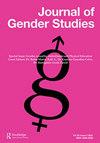Navigating visibility and risk: disabled young women’s self-presentation practices on social media
IF 1.5
3区 社会学
Q2 SOCIAL ISSUES
引用次数: 0
Abstract
Visibility is a requirement of neoliberal postfeminist girlhood and social media is often attributed with the capacity to provide disabled young women with visibility that they lack elsewhere. While some attention has been paid to the intersections of gender and disability through the self-presentations of disabled young women who are known as disabled content creators, such as bloggers and YouTubers, this article goes beyond this to examine how disabled young women represent themselves on social media as part of their everyday practices. Using a combination of discursive textual analysis of Twitter and Instagram accounts and semi-structured interviews with five disabled young women, I explore how affordances such as Twitter retweets play a key role in how disabled young women navigate their visibility online as part of their self-presentation practices. I argue that visibility is potentially risky and disabled young women's social media use is shaped by concerns about harassment and questions about the 'legitimacy' of their disabled identities that operate at the intersections of gender, disability and race, stemming from their experiences of 'systemic disbelief'. Finally, I situate these self-representation practices within the context of the COVID-19 pandemic.导航能见度和风险:残疾年轻女性在社交媒体上的自我展示实践
知名度是新自由主义后女权主义少女时代的要求,社交媒体往往被认为有能力为残疾年轻女性提供其他地方所缺乏的知名度。尽管通过被称为残疾内容创作者的残疾年轻女性(如博客作者和YouTuber)的自我展示,人们对性别和残疾的交叉点给予了一些关注,但本文超越了这一点,研究了残疾年轻女性如何在社交媒体上代表自己,将其作为日常生活的一部分。通过对推特和Instagram账户的话语文本分析,以及对五名残疾年轻女性的半结构化采访,我探索了推特转发等可供性如何在残疾年轻女性如何将其在线可见性作为自我展示实践的一部分中发挥关键作用。我认为,可见性具有潜在风险,残疾年轻女性的社交媒体使用是由对骚扰的担忧和对其残疾身份“合法性”的质疑所决定的,这些身份在性别、残疾和种族的交叉点运作,源于她们的“系统性怀疑”经历。最后,我将这些自我介绍实践置于新冠肺炎大流行的背景下。
本文章由计算机程序翻译,如有差异,请以英文原文为准。
求助全文
约1分钟内获得全文
求助全文
来源期刊

Journal of Gender Studies
Multiple-
CiteScore
4.40
自引率
0.00%
发文量
52
期刊介绍:
The Journal of Gender Studies is an interdisciplinary journal which publishes articles relating to gender from a feminist perspective covering a wide range of subject areas including the Social and Natural Sciences, Arts and Popular Culture. Reviews of books and details of forthcoming conferences are also included. The Journal of Gender Studies seeks articles from international sources and aims to take account of a diversity of cultural backgrounds and differences in sexual orientation. It encourages contributions which focus on the experiences of both women and men and welcomes articles, written from a feminist perspective, relating to femininity and masculinity and to the social constructions of relationships between men and women.
 求助内容:
求助内容: 应助结果提醒方式:
应助结果提醒方式:


